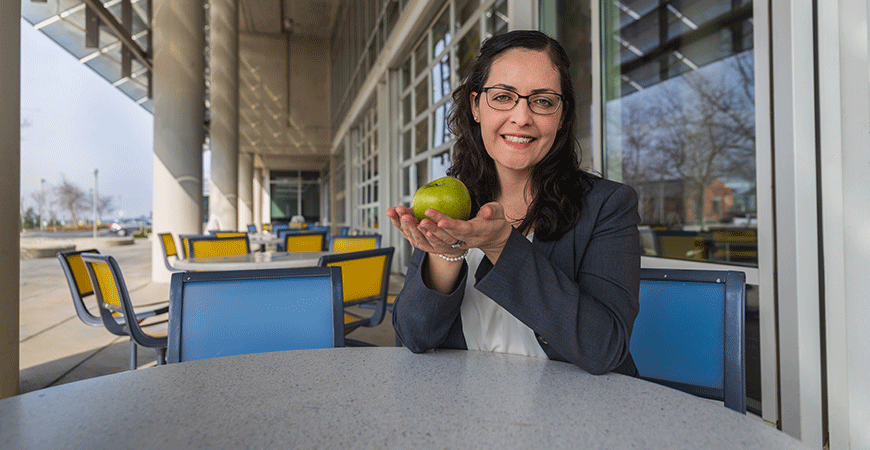
Two faculty members and three graduate students who are working on food systems, food security and food sustainability research have received small grants through the UC Global Food Initiative (GFI) to bolster their projects.
“COVID-19 has really dampened research, so we wanted to find ways to nurture and enhance innovative work during the pandemic,” said Professor Denise Payán, co-lead of the Global Food Initiative UC Merced Campus Collaborative.
She and co-lead UC Cooperative Extension Specialist Karina Díaz Rios, both in the Department of Public Health in the School of Social Sciences, Humanities and Arts (SSHA), along with Campus Collaborative Research Specialist Neha Zahid, selected the recipients from more than a dozen proposals, awarding each of the five projects with up to $1,200 for six months.
The proposals focused on food systems and security, nutrition, dietary behavior, climate health, sustainability, food sovereignty, food waste, and food and nutrition policy, as well as other intersecting topics.
The recipients span the three schools at UC Merced and include:
- Graduate student Vicky Espinoza, Environmental Systems Graduate Group;
- Graduate student Katie Butterfield, Sociology Graduate Group;
- Graduate student Kimberly Sánchez, Public Health Graduate Group;
- Professor Aditya Dasgupta, Department of Political Science, SSHA; and
- Professor Colleen Naughton, Department of Civil and Environmental Engineering, School of Engineering
Espinoza, who works with Professor Joshua Viers, is looking at community-informed land use solutions that help address groundwater overdraft in the San Joaquin Valley in a timely, feasible and equitable manner.
Espinoza is also addressing key knowledge and decision-making equity gaps through workshops and a trilingual (English, Spanish and Hmong) YouTube Channel called “ CaliWaterAg,” which aims to foster a better understanding of groundwater overdraft, land-use transitions and resources available under the Sustainable Groundwater Management Act (SGMA).
She’ll use her grant to elevate the voices of those who have been left out of key water and land use decisions, which have significant impacts on their community and livelihoods.
“By providing information in the native language of our most prominent and underrepresented populations, Latinx and Hmong, I hope to empower them with information that allows them to make SGMA-related decisions appropriate to their and their community’s needs and to become involved in SGMA-related policy decisions,” Espinoza said.
The pandemic has prevented Espinoza from holding in-person workshops, so she wants to grow her YouTube audience. Though her channel has gained traction among agricultural radio stations, online news media, local water agencies, and community and environmental organizations across the Valley, some community members and small-scale farmers may not be tuned in. Some have language barriers, some have limited access to broadband, and many prefer in-person or telephone conversations.
Butterfield, who works with Professor Zulema Valdez, is researching how well community gardens are positioned to address the health and food security needs of those at greatest risk. She is specifically focusing on how race/ethnicity, class and geography influence who benefits from community gardens today.
“Community gardens offer a promising solution to sustainably address disparities in food access and health,” she wrote in her proposal. “By highlighting the barriers for community gardens in reaching disadvantaged populations, as well as strategies for overcoming these barriers, this research provides useful information for maximizing the overall food security benefits of community gardens.”
The grant will allow her to hire an undergraduate student to help create a visually compelling story map to share with the local community. The map would also be publicly accessible online and presented by the undergraduate student at the American Community Garden Association (ACGA) conference in late summer.
Sánchez works with Payán to conduct research on food insecurity and obesity prevention. Her ongoing project uses a modified version of the Nutrition Environment Food Pantry Assessment Tool (NEFPAT) to evaluate the nutritional environment of food distribution centers in the San Joaquin Valley and explores the challenges that distribution centers are facing during COVID-19 as they try to keep up with the high demand for food.
“The GROW grant will help me recruit more distribution sites and expand data collection to highlight food insecurity needs in the Valley and identify areas for improvements,” she said. “In addition, this will allow me to pilot-test the modified NEFPAT tool, which could potentially assess emergency food distribution in a future pandemic.”
The research is part of her second-year thesis work around food insecurity and obesity prevention.
Professor Dasgupta focuses on comparative political and economic development, and said he and one of his graduate students, Ada Johnson-Kanu, have plans for the grant money.
“We are hoping to digitize historical maps of pre-colonial states in Africa to study the impact of pre-colonial institutions on long-run agricultural development and food security,” Dasgupta said. “We hope other scholars working will be able to use the maps, too.”
Grants like this help keep projects going, he said, but they also help attract funding from other sources, too.
Naughton and graduate student Ana Grace Alvarado work together in Naughton’s lab, abbreviated FEW-US, which stands for Food-Energy-Water Systems for the Underserved and all of us in the United States and Globally.
Naughton researches sustainable and culturally sensitive food-energy-water systems. She specializes in methods of Life Cycle Sustainability Assessment, geographic information systems (GIS), integration of anthropology and engineering, and science policy.
The grant will support a project to better understand pineapple production in Costa Rica to help co-design a more sustainable system — environmentally, economically and socially — with communities.
“Ana Grace has seen first-hand in Costa Rica the importance of pineapple production for the local economy, but also the negative environmental and social impacts from intense cultivation and acidification of the soil,” Naughton said.
Each recipient was thankful for the grant and agreed they are encouraging, especially at a time when projects could fall by the wayside. At the end of the six months, the researchers and the Campus Collaborative will have a small virtual gathering, Payán said, to talk about results and progress.
"We're excited to see what they accomplish," Payán said.






